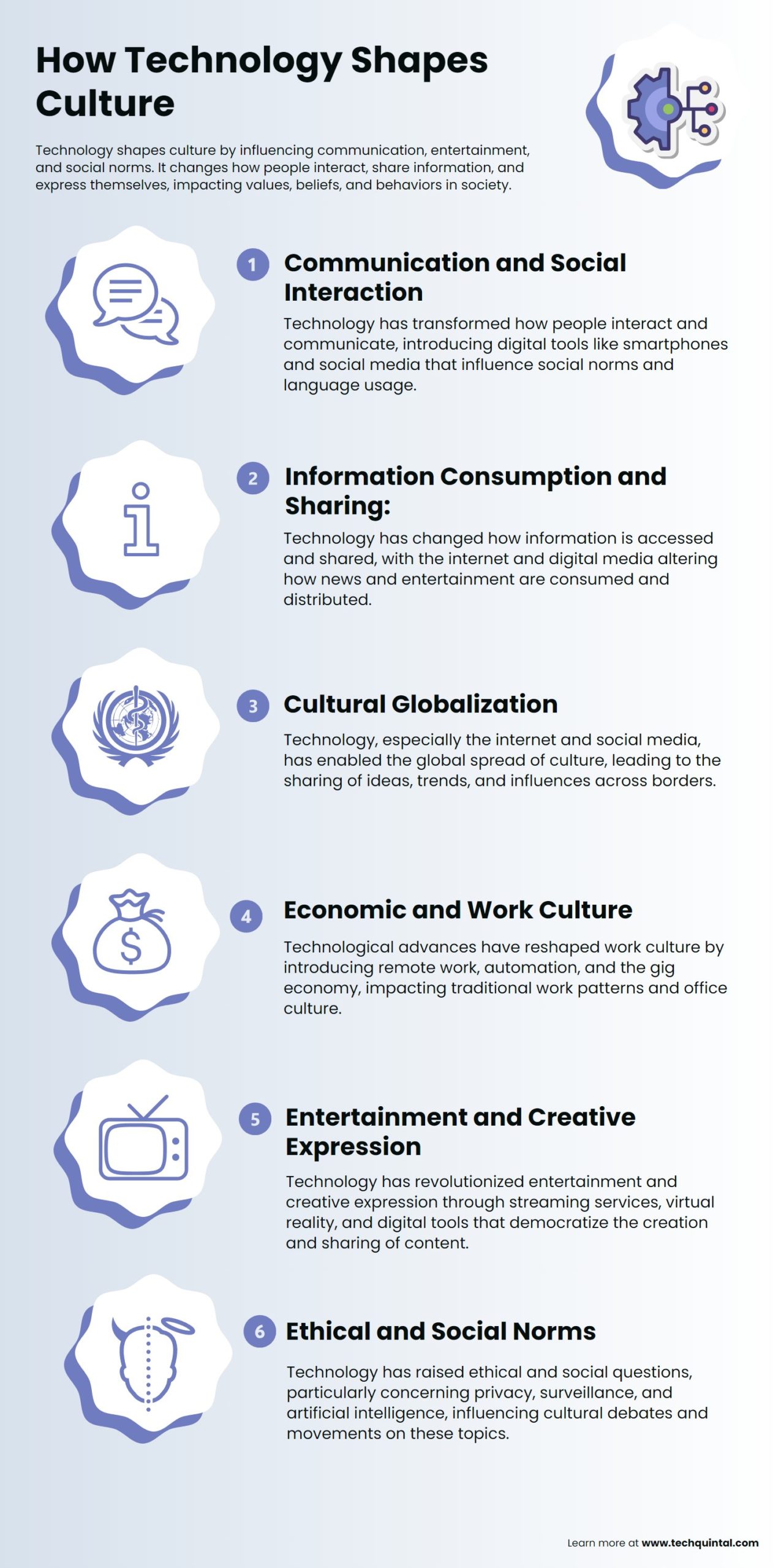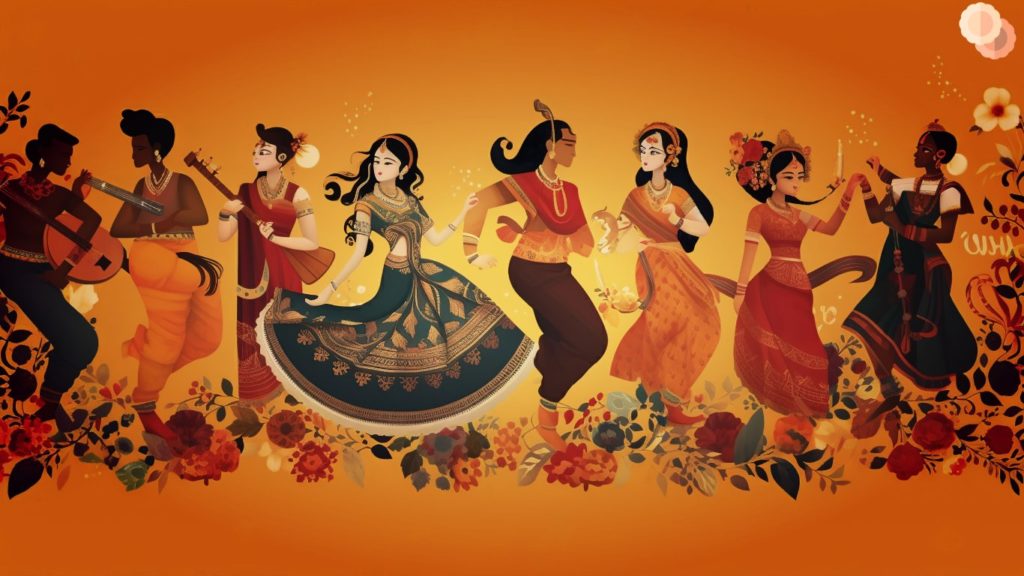
A collection of human beliefs, actions, and ways of living is called culture. It encourages us to attain success and happiness, work effectively, and ensure better future life. To achieve these goals, we look forward to technology. It is a fact that every aspect of our lives is technology-driven, which we use carelessly every day. We cannot deny its existence because we think it is natural. The concept of technology is as old as humans and, so is the culture. They are two forces that influence each other.
When a new technology is introduced to society, the cultural reaction may be positive or negative, resulting in changes forever. These changes, in turn, affect the technology, which develops innovations. From large nuclear reactors to small nanotips, it is the world of technology. By changing the war perception, traditions and beliefs, and lifestyle, culture is greatly affected.
No doubt technology is a tool created from scientific knowledge but, all cultures did not conduct formal experiments. For example, fire and stone tools discovered in the Stone Age were revolutionary forms of technology that shaped the way of living and eating of primitive humans. In the same way, digital technology has shaped the way of living in the modern world. Over time, there has been a significant effect of technology on both local and global culture.
Quick Answer: How Technology Shapes Culture?
Technology shapes culture by influencing communication, entertainment, and social norms. It changes how people interact, share information, and express themselves, impacting values, beliefs, and behaviors in society.
Infographics

Effect of Technology on local culture
To fulfill the basic needs, with resources available at a place, man invented the machine for agriculture. It helped him in tilling, threshing, planting, and harvesting the crop, thus, reducing manual labor in rural areas.
Reduced human need, led to smaller families and, moved to urbanization which was technically advanced, compared to villages. As technology becomes more prevalent in a place, the access to inequality also increases. This unequal access is due to the difference in the income of people. It is called digital division, where a higher income group has greater access than a lower.
Due to this difference, the second division based on the knowledge gap comes into existence. In a tech-based market, a person with technological knowledge is in demand, while the one with low technical acquaintance lags. Thus, technology marks its effect locally which may not be the same in some other places.
Effect of Technology on global culture

Technology is like a pandemic that has affected the whole world. The best way to influence people globally is through media technology. From newspapers to cell phones, the news traveled long back. But now it needs just a click to get information. The internet has the responsibility of bringing people together across national boundaries.
The key to successful communication lies in understanding and respecting all cultural differences, hence enabling a positive impact. And this is possible if we combine both digital and human elements to conduit across borders. In this way, technology has given a common global culture to all the people on earth.
To be more precise, there is yet another way to see how technology is incorporated into other aspects of culture like travel, food, and government. Read our article on technology vs. culture to learn more.
Travel
Technology redefines different cultures and separates one from another, but simultaneously allows us to intermix also. Computer and teleconferencing are the means to access knowledge for an expert learner. Without leaving his home, he can conference in any part of the world. Technology creates more opportunities and also makes every chance affordable.
This advancement allows taking the opportunity which was not availed due to socioeconomic status. It is like permitting a person with a lower income to have access to travel across the world to access the cultural differences and similarities.
Food
Yet another aspect in which culture varies is food. If we look through technology, time spent by people of two different nationalities on food determines its need. Meals in the US are means-to-an-end, eaten in a short period or on the way while traveling, whereas, in French culture, they view meals as a time to enjoy and be together. So the two technologies here are automobiles and fast food. In the US, there are drive-through lanes for fast foods, and speaking through speakers, they pick the food from a window, into a car and, move.
However, there is no such need in France. They need freezers to store the pre-made food to heat in minutes and serve the people socializing at the restaurant. Thus, we see the culture decides which technology should be chosen to access, then shaping it differently according to need.
Government
Technology built the foundation for a democratic society in the US. The cultural and democratic values can be seen through the window of education and the organization of the school system.
Educational democratization has provided children with school facilities irrespective of their social status. That has been made possible only because of the technological skills of communication devices and the democratic system. Promoting online studies by the government in adverse conditions like the pandemic is yet another way in which technology has played a role in helping to go on with studies.
Examples of Technology Affecting Various Cultural Aspects
| Cultural Aspect | Traditional Practices | Impact of Technology |
|---|---|---|
| Language | Learning through textbooks and in-person classes | Digital language learning platforms, translation apps |
| Art and Music | Creation using traditional tools and instruments, sharing through physical exhibitions and performances | Digital creation tools, online sharing and streaming platforms |
| Cultural Preservation | Physical museums, oral storytelling | Virtual reality experiences, digital archives |
| Social Norms | Face-to-face communications, traditional dating methods, cash transactions | Social media interactions, online dating, digital payments |
| Global vs Local Culture | Limited exposure to global culture, predominance of local culture | Increased exposure to global culture alongside the promotion of local culture via technology |
Conclusion
Values about a culture inspire technology, which we saw in some scenarios. Culture accompanied by social situations gives a new definition to technology. Then it gets integrated into the community and, if it fails, it gets adapted to the culture. The advancement of technology depends on the way society or culture wants. Like, the development of an app that allows a farmer to switch on the watering machine though he is away from the field. The growth of Technology depends on the vision of a culture, which is its unique feature.
Hence, the approach to the technology of the two cultures may vary. In the future, it may be possible that besides replicating the need for culture, the role of technology would be to collect the building blocks from various cultures, join them, and create a new model with all the salient features of global technology.
FAQs
Not necessarily. While technology often brings about positive changes, it can also introduce challenges. These can involve issues like digital divide, privacy concerns, and potential loss of certain cultural traditions or skills.
Technology has revolutionized communication through social media, mobile devices, and instant messaging. This has influenced cultural norms around interaction, relationships, and information sharing, creating a shift towards a more globally connected society.
Balancing tradition and technology is complex but possible. By leveraging technology to document, share, and celebrate traditional practices, it’s feasible to maintain cultural heritage in the midst of rapid technological advancement.
Individuals can promote a positive culture by practicing digital etiquette, being mindful of their digital footprint, advocating for equitable access to technology, and utilizing tech tools for creative and beneficial purposes.